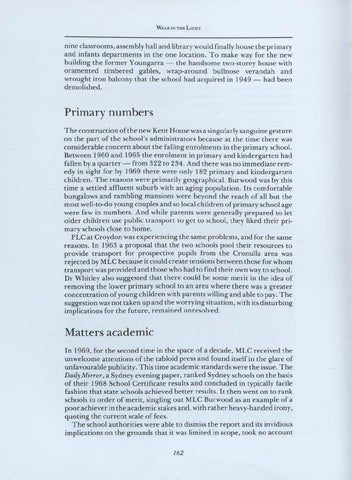WALK IN THE LIGHT
nine classrooms, assembly hall and library would finally house the primary and infants departments in the one location. To make way for the new building the former Youngarra - the handsome two-storey house with oramented timbered gables, wrap-around bullnose verandah and wrought iron balcony that the school had acquired in 1949 - had been demolished.
Primary numbers The construction ofthe new Kent House was a singularly sanguine gesture on the part of the school's administrators because at the time there was considerable concern about the falling enrolments in the primary school. Between 1960 and 1965 the enrolment in primary and kindergarten had fallen by a quarter - from 322 to 234. And there was no immediate remedy in sight for by 1969 there were only 182 primary and kindergarten children. The reasons were primarily geographical. Burwood was by this time a settled affluent suburb with an aging population. Its comfortable bungalows and rambling mansions were beyond the reach of all but the most well-to-do young couples and so local children of primary school age were few in numbers. And while parents were generally prepared to let older children use public transport to get to school, they liked their primary schools close to home. PLC at Croydon was experiencing the same problems, and for the same reasons. In 1963 a proposal that the two schools pool their resources to provide transport for prospective pupils from the Cronulla area was rejected by MLC because it could create tensions between those for whom transport was provided and those who had to find their own way to school. Dr Whitley also suggested that there could be some merit in the idea of removing the lower primary school to an area where there was a greater concentration of young children with parents willing and able to pay. The suggestion was not taken up and the worrying situation, with its disturbing implications for the future, remained unresolved.
Matters academic In 1969, for the second time in the space of a decade, MLC received the unwelcome attentions of the tabloid press and found itself in the glare of unfavourable publicity. This time academic standards were the issue. The Daily Mirror, a Sydney evening paper, ranked Sydney schools on the basis of their 1968 School Certificate results and concluded in typically facile fashion that state schools achieved better results. It then went on to rank schools in order of merit, singling out MLC Burwood as an example of a poor achiever in the academic stakes and, with rather heavy-handed irony, quoting the current scale of fees. The school authorities were able to dismiss the report and its invidious implications on the grounds that it was limited in scope, took no account 162
